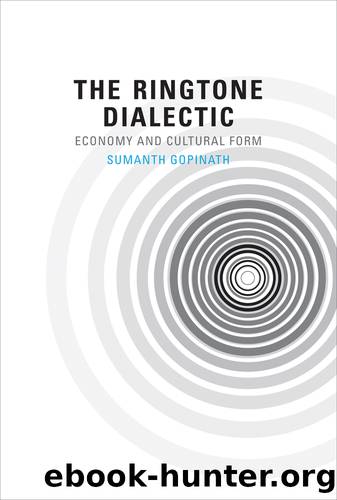The Ringtone Dialectic by Gopinath Sumanth;

Author:Gopinath, Sumanth; [Gopinath, Sumanth]
Language: eng
Format: epub
ISBN: 3339647
Publisher: MIT Press
Published: 2013-12-04T00:00:00+00:00
7
A Spectrum of Forms:
The Aesthetic Logic of Original Sound-File Ringtone Composition
I basically use my ears, and my creativity and do it over and over again.
âBrice Salek, Ringtone Records1
What does it mean to compose a ringtone? The question is not trivial, for there are few universals associated with mobile phone ringtones themselves now that they are digital sound files (usually MP3s) often of any length. (They are, nonetheless, conventionally around 15â30 seconds long and often subject to length restrictions. Appleâs iPhone formal maximum for ringtones is 40 seconds, but this restriction is easily bypassed.2) Certainly, original monophonic and polyphonic ringtones were composed (semi-) anonymously as part of the labor of ringtone production (as discussed in chapter 2), and labels such as the German company GoFresh produced original polyphonic ringtones for sale outside of established ringtone-industry contexts (i.e., wireless providers and mobile entertainment firms selling popular song-based ringtones).3 Moreover, experimental algorithmic-compositional projects for creating new ringtones existed in the polyphonic period: perhaps the best-known is WolframTones, the MIDI file generator inspired by the work of Stephen Wolfram and produced by algorithms realized using the software package Mathematica.4
But the creation of new ringtones took a qualitative and quantitative leap forward as a result of the possibility of placing potentially any sound file on a cell phone, to be played back on the phoneâs ambient speaker, which is usually used for ringtones and other alert-signal sounds, as well as its speakerphone function.5 As I argued in chapter 4, precisely on account of their simplicity or primitiveness, depending on your viewpoint, the earlier forms of the ringtoneâespecially the monophonic ringtoneâprovided the most distinctive sonic material that artists and composers could employ in the context of new concert music compositions, interactive multimedia performances, or art installations. The dialectical closure of this creative possibility was signaled by the emergence of the sound-file ringtoneâwhich could either merely mimic the older phone models through prerecorded sounds or transform mobile phones into mobile audio playback and multimedia devices, thus rendering their ringtone-specific features less central.6 However, the new technological moment of the sound-file ringtone also resulted in a dialectical opening of new possibilities for original ringtone composition, with original ringtone albums increasing in number and availability from the early 2000s, just as sound-file ringtones were starting to appear on higher-end phones: in particular, as the ringtone became less sonically distinctive, it transformed into a more capacious vehicle for a wide variety of sounds. Of course, new constraints imposed themselves, the primary ones being the influence of preexisting music and sound recording genres (including various music genresâsongs, long-form instrumental compositions, electroacoustic music, etc.âand comedy recordings), which were absorbed into the new medium in a partly parasitic manner; the technological constraints of duration during the early sound-file ringtone moment (roughly between 2003 and 2007) and the resulting temporal limits residually remaining as a convention of the âringtone genreâ; and the constraints imposed as a result of scenarios for the use of mobile devicesâtypically, that ringtones can expect to be interrupted, and that
Download
This site does not store any files on its server. We only index and link to content provided by other sites. Please contact the content providers to delete copyright contents if any and email us, we'll remove relevant links or contents immediately.
| American National Standards Institute (ANSI) Publications | Architecture |
| History | Measurements |
| Patents & Inventions | Research |
Whiskies Galore by Ian Buxton(41525)
Introduction to Aircraft Design (Cambridge Aerospace Series) by John P. Fielding(32885)
Small Unmanned Fixed-wing Aircraft Design by Andrew J. Keane Andras Sobester James P. Scanlan & András Sóbester & James P. Scanlan(32569)
Craft Beer for the Homebrewer by Michael Agnew(17928)
Turbulence by E. J. Noyes(7694)
The Complete Stick Figure Physics Tutorials by Allen Sarah(7135)
Kaplan MCAT General Chemistry Review by Kaplan(6591)
The Thirst by Nesbo Jo(6432)
Bad Blood by John Carreyrou(6271)
Modelling of Convective Heat and Mass Transfer in Rotating Flows by Igor V. Shevchuk(6219)
Learning SQL by Alan Beaulieu(6029)
Weapons of Math Destruction by Cathy O'Neil(5824)
Man-made Catastrophes and Risk Information Concealment by Dmitry Chernov & Didier Sornette(5643)
Digital Minimalism by Cal Newport;(5388)
Life 3.0: Being Human in the Age of Artificial Intelligence by Tegmark Max(5182)
iGen by Jean M. Twenge(5158)
Secrets of Antigravity Propulsion: Tesla, UFOs, and Classified Aerospace Technology by Ph.D. Paul A. Laviolette(4980)
Design of Trajectory Optimization Approach for Space Maneuver Vehicle Skip Entry Problems by Runqi Chai & Al Savvaris & Antonios Tsourdos & Senchun Chai(4837)
Electronic Devices & Circuits by Jacob Millman & Christos C. Halkias(4741)
